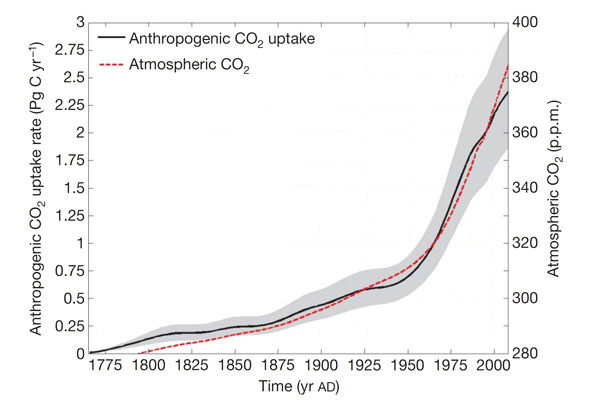Reference
Khatiwala, S. Primeau, F. and Hall, T. 2009. Reconstruction of the history of anthropogenic CO2 concentrations in the ocean. Nature 462: 346-349.
Background
The release of fossil-fuel-derived CO2 to the atmosphere by human activity has been claimed by many to have played a dominant role in 20th-century global warming; and the authors note that the world's oceans play "a crucial role in mitigating the effects of this perturbation to the climate system." Hence, it is important to determine whether or not - and by how much - the strength of this mitigating factor might be changing with the passage of time.
What was done
Khatiwala et al. derived, as they describe it, "an observationally based reconstruction of the spatially-resolved, time-dependent history of anthropogenic carbon in the ocean over the industrial era [AD 1765 to AD 2008]," based on the known history of the air's CO2 concentration and analyses of the oceanic transport of "a suite of well sampled oceanic tracers such as chlorofluorocarbons, natural 14C, temperature, and salinity from the GLODAP and World Ocean Atlas databases."
What was learned
The three U.S. researchers determined that the amount of anthropogenic CO2 taken up by the world's oceans has been continually increasing with the passage of time, pretty much in phase with the atmosphere's ever-increasing CO2 concentration, as shown in the figure below.

Atmospheric CO2 concentration and oceanic uptake rate of anthropogenic carbon (with shaded error envelope) plotted against time. Adapted from Khatiwala et al. (2009).
In addition, Khatiwala et al. note that after the sharp increase in the anthropogenic CO2 uptake rate after the 1950s, there has been "a small decline in the rate of increase in the last few decades." However, as may readily be seen in the figure above, this latest deviation of the oceanic CO2 uptake rate (from its correlation with the atmosphere's CO2 concentration) is similar to those of prior such deviations, which have been of both a positive and negative nature. And the size of the shaded error envelope associated with the anthropogenic CO2 uptake rate allows for the possibility that its correlation with the atmosphere's CO2 concentration could well have been essentially perfect from about the 1860s through and including the present time.
What it means
Writing about the research of Khatiwala et al. in the 19 November 2009 issue of The New York Times, Sindya Bhanoo gives a distinctly climate-alarmist slant to the scientists' findings, stating that the growth in the ocean's uptake rate of anthropogenic carbon "has slowed since the 1980s, and markedly so since 2000," with the implication that "the research suggests that the seas cannot indefinitely be considered a reliable 'carbon sink' as humans generate heat-trapping gases." In fact, Bhanoo quotes Khatiwala himself as saying that the recent trend to lower values of the ocean's uptake rate of anthropogenic carbon "implies that more of the emissions will remain in the atmosphere."
Quite to the contrary, however, the finely-intertwined relationship of the two parameters of the above figure clearly demonstrates - and well within the accuracy of the various measurements involved - that the global ocean is constantly adjusting its uptake rate of anthropogenic carbon on multi-decadal time scales to continually "keep up" with the rate at which the air's CO2 content rises in response to anthropogenic carbon inputs.
Clearly, there is no real "news" to report on this issue; and, therefore, one can only conclude that the Times merely sees the Khatiwala et al. publication as little more than a "golden" opportunity to promote the need for a "green" agenda, in the hope that no one will seriously peruse the materials they cite in substantiation of their claim.
Reference
Bhanoo, S. N. 2009. Seas grow less effective at absorbing emissions. The New York Times (19 November).




